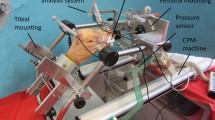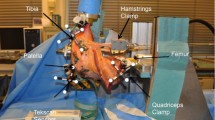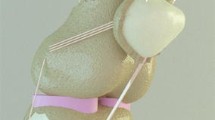Abstract
Purpose
Torsional osteotomy of the distal femur allows anatomic treatment of patellofemoral instability and patellofemoral pain syndrome in cases of increased femoral antetorsion. The purpose of this study was to investigate the effects of distal femoral torsional osteotomy on pressure distribution of the medial and lateral patellar facet.
Methods
Nine fresh frozen human knee specimens were embedded in custom-made 3D-printed casts and tested with a robotic arm. Torsional osteotomy could be simulated ranging from increased femoral antetorsion of 25° with a corresponding lateralization of the patella to an overcorrected value of 5° of femoral antetorsion. The peak and mean lateral and medial compartment pressure was measured in 0°, 15°, 30°, 45°, 60° and 90° flexion beginning with neutral anatomic muscle rotation.
Results
The medial aspect of the patella showed a significant influence of femoral torsion with an increase of mean and peak pressure in all flexion angles with progressive derotation from 15° external rotation to 5° internal rotation (p = 0.004). The overall pressure difference was highest in near extension and stayed on a constant level with further flexion. On the lateral facet, the derotation resulted in decrease of pressure in near extension; however, it had no significant influence on the mean and peak pressure through the different torsion angles (n.s.). Unlike on the medial facet, a significant consistent increase of peak pressure from 0° to 90° flexion could be shown (p = 0.022) on the lateral patella aspect.
Conclusion
Distal femoral torsional osteotomy to correct pathological femoral antetorsion leads to a redistribution of retropatellar pressure. External derotation leads to an increased peak pressure on the medial patellar facet and can impair simultaneous cartilage repair. However, as the lateral patellofemoral load decreases, it has a potential in preventing patellofemoral osteoarthritis.



Similar content being viewed by others
References
Aglietti P, Buzzi R, Insall J (2001) Disorders of the patellofemoral joint. In: Insall JN, Scott WN (eds) Surgery of the knee, 3. edn. Churchill Livingstone, Philadelphia, pp 913–1043
Bauer S, Khan RJ, Ebert JR et al (2012) Knee joint preservation with combined neutralising high tibial osteotomy (HTO) and matrix-induced autologous chondrocyte implantation (MACI) in younger patients with medial knee osteoarthritis: a case series with prospective clinical and MRI follow-up over 5 years. Knee 19:431–443
Brimacombe JM, Wilson DR, Hodgson AJ, Ho KC, Anglin C (2009) Effect of calibration method on Tekscan sensor accuracy. J Biomech Eng 131:034503 1–4
Brinkman JM, Freiling D, Lobenhoffer P, Staubli AE, van Heerwaarden RJ (2014) Supracondylar femur osteotomies around the knee: patient selection, planning, operative techniques, stability of fixation, and bone healing. Orthopade 43(Suppl;1):1–10
Bruce WD, Stevens PM (2004) Surgical correction of miserable malalignment syndrome. J Pediatr Orthop 24:392–396
Dickschas J, Harrer J, Pfefferkorn R, Strecker W (2012) Operative treatment of patellofemoral maltracking with torsional osteotomy. Arch Orthop Trauma Surg 132:289–298
Dye SF (2005) The pathophysiology of patellofemoral pain: a tissue homeostasis perspektive. Clin Orthop Relat Res 436:100–110
Drewniak EI, Crisco JJ, Spenciner DB, Fleming BC (2007) Accuracy of circular contact area measurements with thin-film pressure sensors. J Biomech 40:2569–2572
Eckhoff DG, Montgomery WK, Kilcoyne RF, Stamm ER (1994) Femoral morphometry and anterior knee pain. Clin Orthop Relat Res 302:64–68
Farahmand F, Senavongse W, Amis AA (1998) Quantitative study of the quadriceps muscles and trochlear groove geometry related to instability of the patellofemoral joint. J Orthop Res 16:136–143
Farahmand F, Tahmasbi MN, Amis AA (1998) Lateral force–displacement behaviour of the human patella and its variation with knee flexion: a biomechanical study in vitro. J Biomech 31:1147–1152
Farr J, Covell DJ, Lattermann C (2012) Cartilage lesions in patellofemoral dislocations: incidents/locations/when to treat. Sports Med Arthrosc Rev 20:181–186
Frosch S, Balcarek P, Walde TA et al (2011) The treatment of patellar dislocation: a systematic review. Z Orthop Unfall 149:630–645
Fu FH, Zurakowski D, Browne JE et al (2005) Autologous chondrocyte implantation versus debridement for treatment of full-thickness chondral defects of the knee: An observational cohort study with 3-year follow-up. Am J Sport Med 33:1658–1666
Guettler JH, Demetropoulos CK, Yang KH, Jurist KA (2004) Osteochondral defects in the human knee: influence of defect size on cartilage rim stress and load redistribution to surrounding cartilage. Am J Sports Med 32:1451–1458
Heegaard J, Leyvraz PF, Curnier A, Rakotomanan L, Huiskes R (1995) The biomechanics of the human patella during passive knee flexion. J Biomech 28:1265–1279
Hinterwimmer S, Minzlaff P, Saier T, Niemeyer P, Imhoff AB, Feucht MJ (2014) Biplanar supracondylar femoral derotation osteotomy for patellofemoral malalignment: the anterior closed-wedge technique. Knee Surg Sports Traumatol Arthrosc 22:2518–2521
Kuroda R, Kambic H, Valdevit A et al (2001) Articular cartilage contact pressure after tibial tuberosity transfer. A cadaveric study. Am J Sports Med 29:403–409
Lee TQ, Anzel SH, Bennett KA et al (1994) The influence of fixed rotational deformities of the femur on the patellofemoral contact pressures in human cadaver knees. Clin Orthop Relat Res 302:69–74
Liska F, Voss A, Imhoff FB, Willinger L, Imhoff AB (2018) Nonunion and delayed union in lateral open wedge distal femoral osteotomies-a legitimate concern? Int Orthop 42(1):9–15
Liu JN, Steinhaus ME, Kalbian IL, Post WR, Green DW, Strickland SM, Shubin Stein BE (2017) Patellar instability management: a survey of the international patellofemoral study group. Am J Sports Med. https://doi.org/10.1177/0363546517732045
Mäenpää H, Lehto MUK (1997) Patellofemoral osteoarthritis after patellar dislocation. Clin Orthop Relat Res 339:156–162
Mashoof AA, Scholl MD, Lahav A, Greis PE, Burks RT (2005) Osteochondral injury to the mid-lateral weight-bearing portion of the lateral femoral condyle associated with patella dislocation. Arthroscopy 21:228–232
Mehta VM, Inoue M, Nomura E, Fithian DC (2007) An algorithm guiding the evaluation and treatment of acute primary patellar dislocations. Sports Med Arthrosc Rev 15:78–81
Merican AM, Amis AA (2009) Iliotibial band tension affects patellofemoral and tibiofemoral kinematics. J Biomech 42:1539–1546
Mueller O, Lo JH, Wuenschel M, Obloh C, Wuelker N (2009) Simulation of force loaded knee movement in a newly developed in vitro knee simulator. Biomed Eng 54(3):142–149
Nelitz M, Dreyhaupt J, Williams SR, Dornacher D (2015) Combined supracondylar femoral derotation osteotomy and patellofemoral ligament reconstruction for recurrent patellar dislocation and severe femoral anteversion syndrome: surgical technique and clinical outcome. Int Orthop 39:2355–2362
Nomura E, Inoue M, Kurimura M (2003) Chondral and osteochondral injuries associated with acute patellar dislocation. Arthroscopy 19:717–721
Nomura E, Inoue M (2005) Second-look arthroscopy of cartilage changes of the patellofemoral joint, especially the patella, following acute and recurrent patellar dislocation. Osteoarthr Cartil 13:1029–1036
Panagiotopoulos E, Strzelczyk P, Herrmann M, Scuderi G (2006) Cadaveric study on static medial patellar stabilizers: the dynamizing role of the vastus medialis obliquus on medial patellofemoral ligament. Knee Surg Sports Traumatol Arthrosc 14(1):7–12
Sheehan FT, Derasari A, Fine KM, Brindle TJ, Alter K (2010) Q-angle and J-sign: Indicative of Maltracking Subgroups in Patellofemoral Pain. Clin Orthop Relat Res 468(1):266–275
Staheli LT (1989) Torsion–treatment indications. Clin Orthop Relat Res 247:61–66
Stanitski CL, Paletta GA Jr (1998) Articular cartilage injury with acute patellar dislocation in adolescents. Arthroscopic and radiographic correlation. Am J Sports Med 26:52–55
Stephen JM, Lumpaopong P, Dodds AL, Williams A, Amis AA (2015) The effect of tibial tuberosity medialization and lateralization on patellofemoral joint kinematics, contact mechanics, and stability. Am J Sports Med 43(1):186–194
Strecker W, Dickschas J (2015) Torsional osteotomy: Operative treatment of patellofemoral maltracking. Oper Orthop Traumatol 27:505–524
Tang WC, Henderson IJ (2005) High tibial osteotomy: long term survival analysis and patients’ perspective. Knee 12:410–413
Funding
The Technical University of Munich has received direct funding from the German Arthritis Foundation and the German speaking Society for Arthroscopy and Joint Surgery (AGA).
Author information
Authors and Affiliations
Corresponding author
Ethics declarations
Conflict of interest
The authors declare that they have no conflict of interest.
Ethical approval
This article does not contain any studies with human participants or animals performed by any of the authors.
Rights and permissions
About this article
Cite this article
Liska, F., von Deimling, C., Otto, A. et al. Distal femoral torsional osteotomy increases the contact pressure of the medial patellofemoral joint in biomechanical analysis. Knee Surg Sports Traumatol Arthrosc 27, 2328–2333 (2019). https://doi.org/10.1007/s00167-018-5165-2
Received:
Accepted:
Published:
Issue Date:
DOI: https://doi.org/10.1007/s00167-018-5165-2




